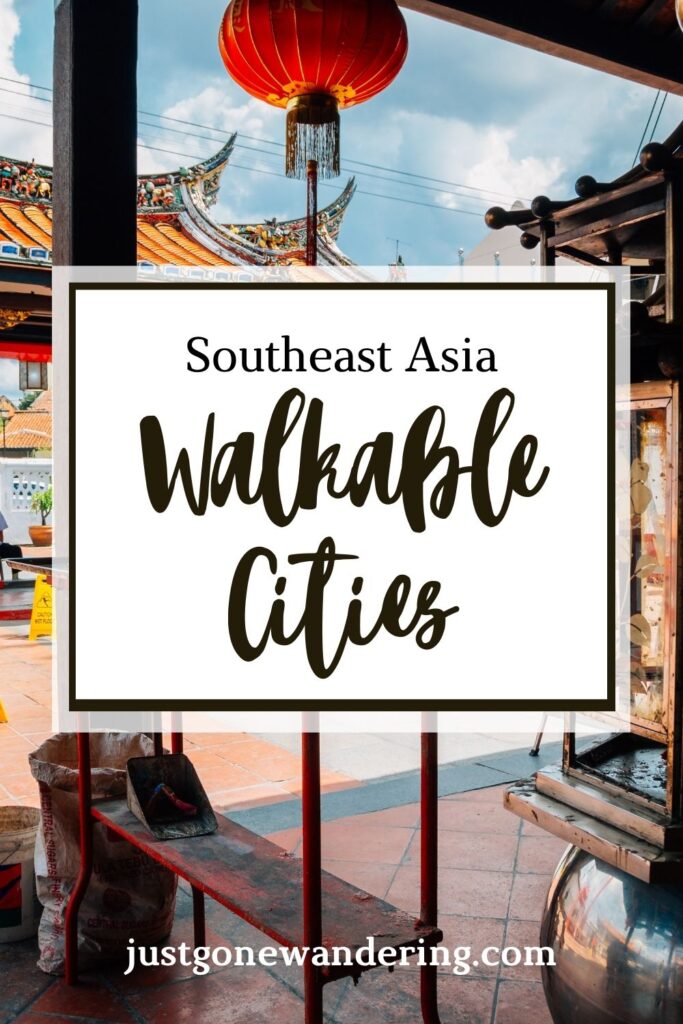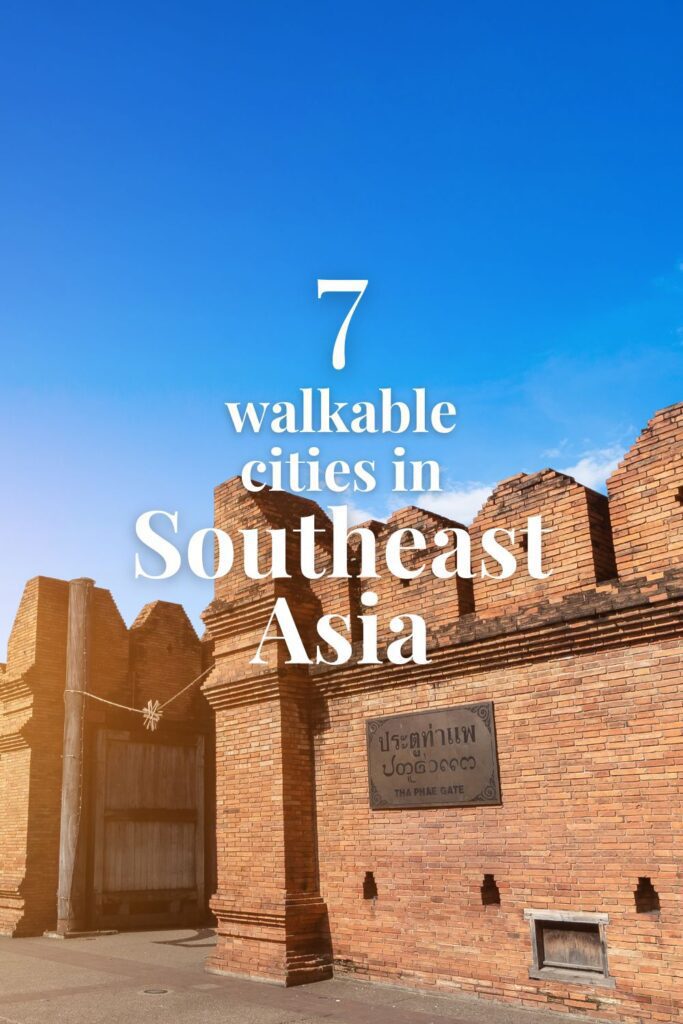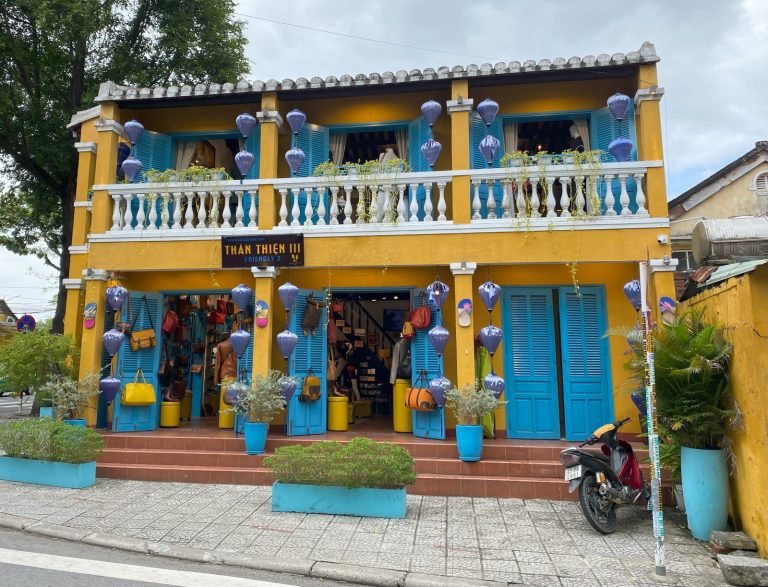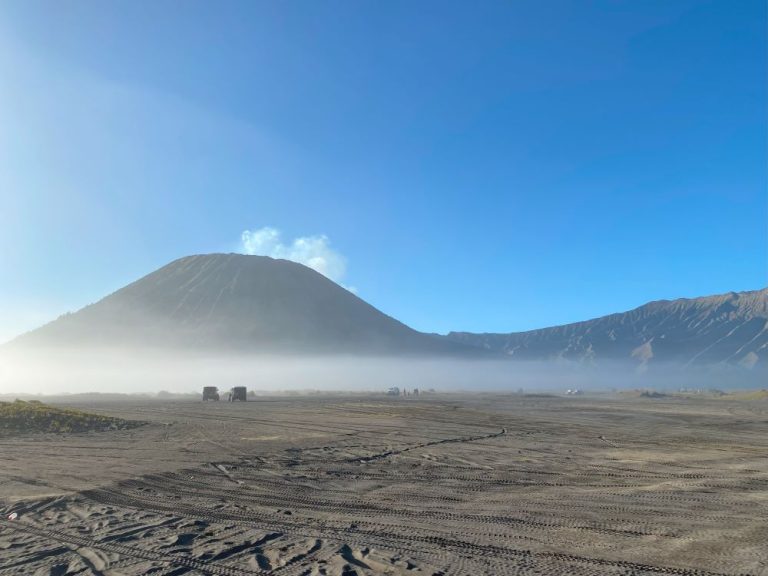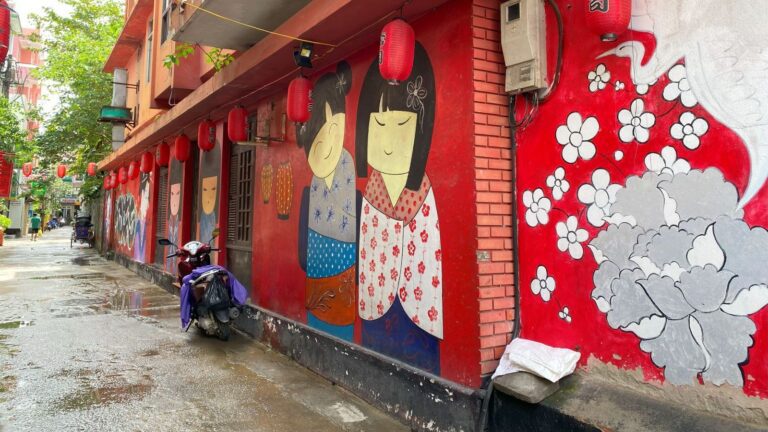7 Walkable Cities in Southeast Asia
When nomads look for new places to stay for a while, walkability is a big factor in most people’s decision-making. It’s easier to get around a place if you can walk safely to wherever you need to go, especially if there isn’t good public transit options.
One question I see a lot from digital nomads, expats and slow travelers is: which cities in Southeast Asia are walkable?
Usually this comes up when someone’s trying to decide where to stay for a month or more, and there’s too many choices. Having traveled around Asia, and mostly in Southeast Asia for over a year now, and as someone who refuses to drive, I’m very qualified to answer the question of which cities are more or less walkable while still being interesting for travelers. 😉
This post is a collection of places in Southeast Asia that I feel are particularly walkable, or that have a good mix of “mostly walkable” and “interesting stuff to see.” I’ll discuss my experiences walking around those cities as a tourist, and also talk about what walkability actually means in the context of Southeast Asia.
Just Gone Wandering is supported by readers! This post contains affiliate links. If you click on a link and buy something, I get a small percentage at no extra cost to you. Your support helps keep this blog running— thank you! Read full disclosure here.
What’s “walkable,” anyway?
How you define “walkable” might differ from how I define it, and even then what’s “walkable” in Southeast Asia may not be the same sort of “walkable” you’d be used to in Europe or some American cities. So!
What’s walkable mean?
Basically, it means that amenities are accessible by foot within a reasonable distance from your home/hotel/etc.
A walkable neighborhood means you can go to the store to get groceries, visit your dentist, and send a package within a small radius of where you live. Your school is nearby, and your church and even your workplace.
Usually there’s a smaller neighborhood within a larger city that’s built just like that, and thus more walkable than maybe the city as a whole.
For Americans, we mostly live in big spread-out cities that mean you have to drive everywhere, but think about NYC or Chicago. These are big cities with walkable neighborhoods (more or less), and the further-out places can be reached by public transportation. There are cities just like that in Southeast Asia!
Furthermore, for tourists and travelers, “walkable” cities can also mean there’s sightseeing opportunities within walking distance (or quick public transit ride), and that they can get to those sights safely.
Walkability in Southeast Asia
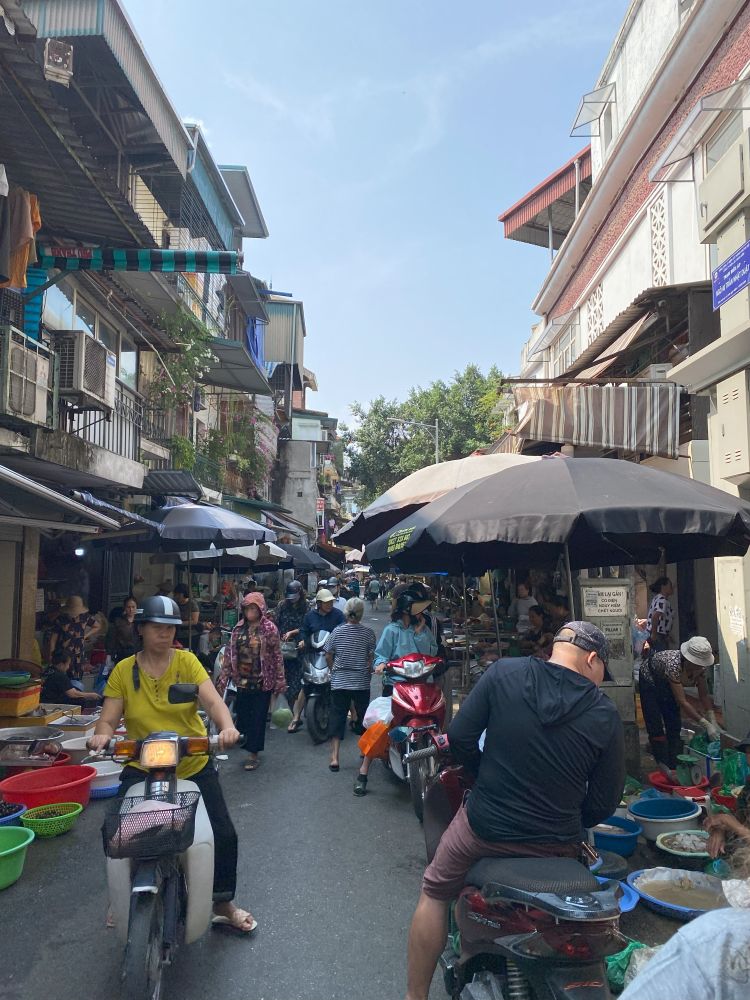
For Southeast Asia, the difficulty increases because in most countries the locals get around by scooter or car, and the sidewalks aren’t really for pedestrians. Sidewalks are where the scooters are kept, and not for people to walk on. You’ll see lots of broken concrete, tree roots poking through, bricks coming up out of their setting and lots more problems. Plus sometimes the sidewalk is super narrow, or just stops in the middle of the street.
So basically, “walkable” in Southeast Asia usually isn’t tied to how big or nice the sidewalks are.
Further problems: Pedestrian crossings may not have clear signage, traffic buttons, or even be in useful locations. You may have to share your walking space with scooters, cars, and bicycles. And businesses tend to use sidewalks as a storage space for inventory.
A secondary concern is bad air quality, where you wouldn’t want to spend time walking around outside much because it could make you sick. And finally, you need to consider the weather/temperature. Southeast Asia is, in general, very hot! Most cities don’t consider things like shade outside of parks, so you could be walking under bright sun all day.
I’ll discuss those issues within each section so you can get a good idea of the kind of walkability they actually have. I’ll include photos of sidewalks (if I have them) but keep in mind that sidewalks aren’t the end-all measure for walkability in SEA. You simply won’t get the same kind of walkability in SEA that you might get in Western Europe or even the US, okay?
The other thing to consider is that some neighborhoods are more walkable than others, so I’ve specifically picked out recommended places to stay if you’re planning on staying in the city for a while (a month or more).
Okay, onward!
1. Chiang Mai, Thailand
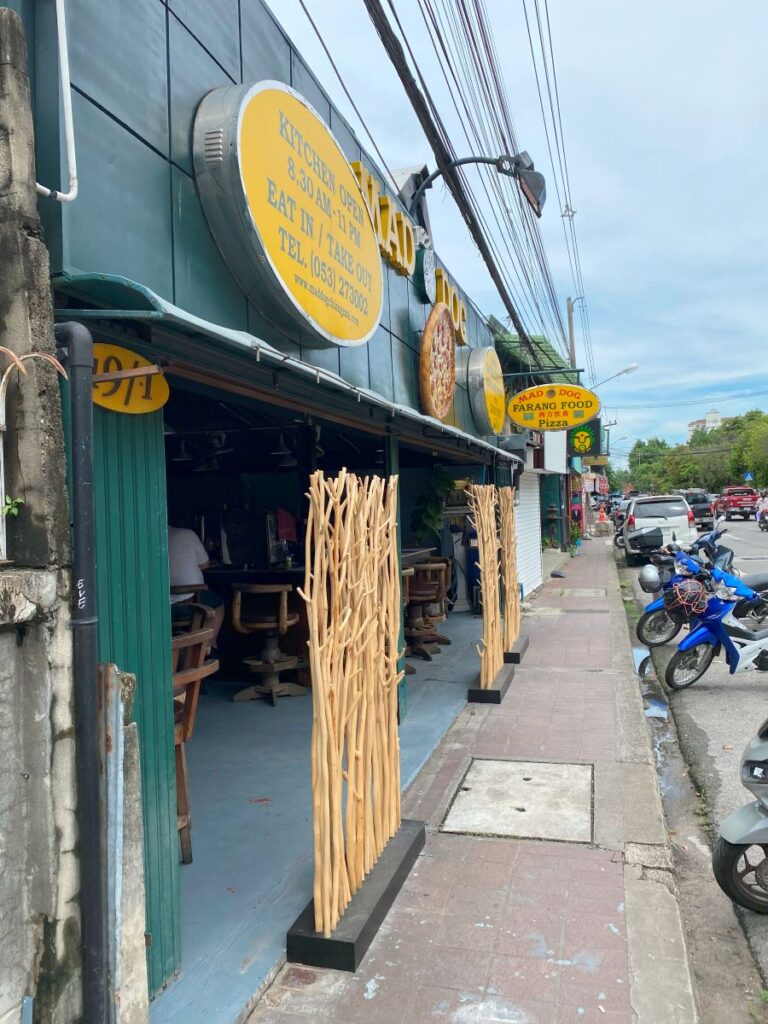
Chiang Mai is one of the most popular destinations for digital nomads and slow travelers alike, well known for its wonderful food, friendly locals, and excellent cost of living. It’s also one of the more walkable cities on this list! The sidewalks are, more than most places, well-maintained, clear of “stuff” and fairly wide.
While it’s not perfect, the compact city center and relaxed pace make it relatively pedestrian-friendly for Southeast Asia.
Related: Street Art Spotlight: Chiang Mai, Thailand
Positives
- Old City Charm: The Old City is one of the most walkable areas in Chiang Mai. It’s enclosed by a square moat and ancient walls, making it easy to navigate. Within this area, you’ll find cafes, temples like Wat Chedi Luang, and night markets, all within walking distance.
- Compact Size: Chiang Mai’s central area isn’t sprawling, so even outside the Old City, neighborhoods like Nimmanhaemin and Santitham are reasonably walkable, with access to amenities and dining options.
- Community Vibe: The city is laid-back, with many expat-friendly spots catering to slow travelers, such as coworking spaces, yoga studios, and vegetarian restaurants.
Challenges
- Sidewalks and Traffic: While the Old City has some sidewalks, they can be narrow or obstructed, and crossing busy streets requires caution. Tiny side streets have uneven pavements or even NO sidewalks, meaning pedestrians have to go into roads shared by scooters and cars. However, if you go outside the Old City there’s some very nice sidewalks and wider walking areas.
- Air Quality: Between February and April, Chiang Mai experiences a “burning season” when farmers burn crops, causing poor air quality. Walking outdoors during this period can be dangerous– definitely wear a good filtration mask if you’re in the city during this time.
Neighborhoods of Interest
- Old City: The heart of Chiang Mai, perfect for exploring temples, markets, and street food. You can easily walk to landmarks like Tha Phae Gate and the Sunday Walking Street Market. Lots of hostels to stay in!
- Nimmanhaemin: Popular with digital nomads, this trendy neighborhood offers walkable access to boutique shops, cafes with great Wi-Fi, and Maya Lifestyle Shopping Center. Nice apartments in bigger buildings with more amenities, nicer sidewalks and more space to walk.
- Santitham: A quieter neighborhood with a mix of local charm and expat-friendly amenities. It’s less touristy but still has walkable access to markets, small eateries, and coworking spots.
2. George Town, Malaysia
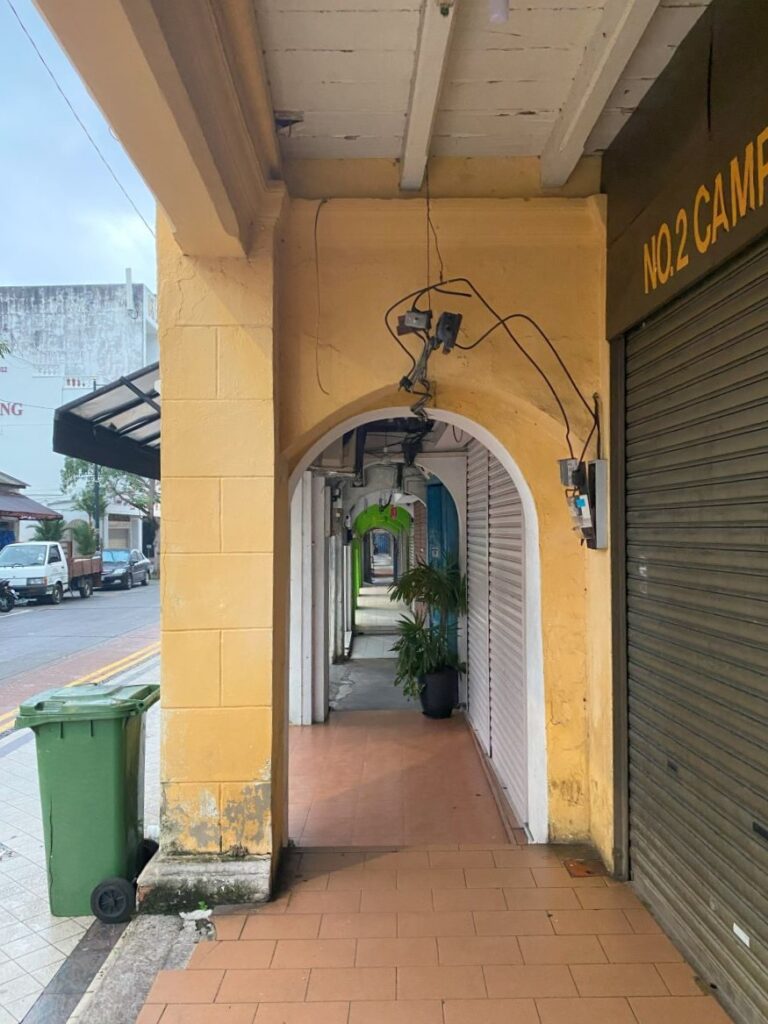
George Town, the capital of Penang, is a UNESCO World Heritage Site known for its vibrant cultural blend and historic charm. Its compact size and well-preserved architecture make it a favorite for slow travelers who enjoy exploring on foot, and it’s a popular destination for people who want to get away from big cities like Kuala Lumpur.
Positives
- Historic Core: The city’s heritage area is highly walkable, with narrow streets lined with shophouses, murals, and historic landmarks like the Khoo Kongsi clan house. Street signs and maps make navigation straightforward, and the wide sidewalks are in good condition.
- Street Food and Cafes: George Town is famous for its hawker food, and many stalls are concentrated in easily walkable areas. You can sample iconic dishes like char kway teow and Penang laksa without needing transportation.
- Art and Culture: The city has a lot of street art and cultural attractions, including museums and temples. Exploring on foot allows you to take in these details at your own pace.
Challenges
- Sidewalk Conditions: While some areas are pedestrian-friendly, outside of the main tourist areas the sidewalks are fairly narrow. Sidewalks outside of restaurants and stores tend to have boxes, tables, and other stuff on them which means a lot of dodging around obstructions. Be cautious, especially during busy times.
- Tropical Heat: The weather in George Town can be hot and humid, which might make walking long distances uncomfortable without frequent breaks. Many people end up using Grab to get around, which at least is affordable.
Neighborhoods of Interest
- Heritage Zone: The most walkable part of the city, featuring landmarks like Fort Cornwallis, Armenian Street’s street art, and the Pinang Peranakan Mansion. I stayed in Yeng Keng Hotel in this area and really enjoyed it!
- Little India: A vibrant neighborhood with shops, temples, and eateries, all within a compact area perfect for walking. A good choice if you want Indian food, too.
- Gurney Drive: Slightly outside the main heritage zone, this area offers a scenic waterfront promenade and is walkable for dining and shopping.
3. Malacca, Malaysia
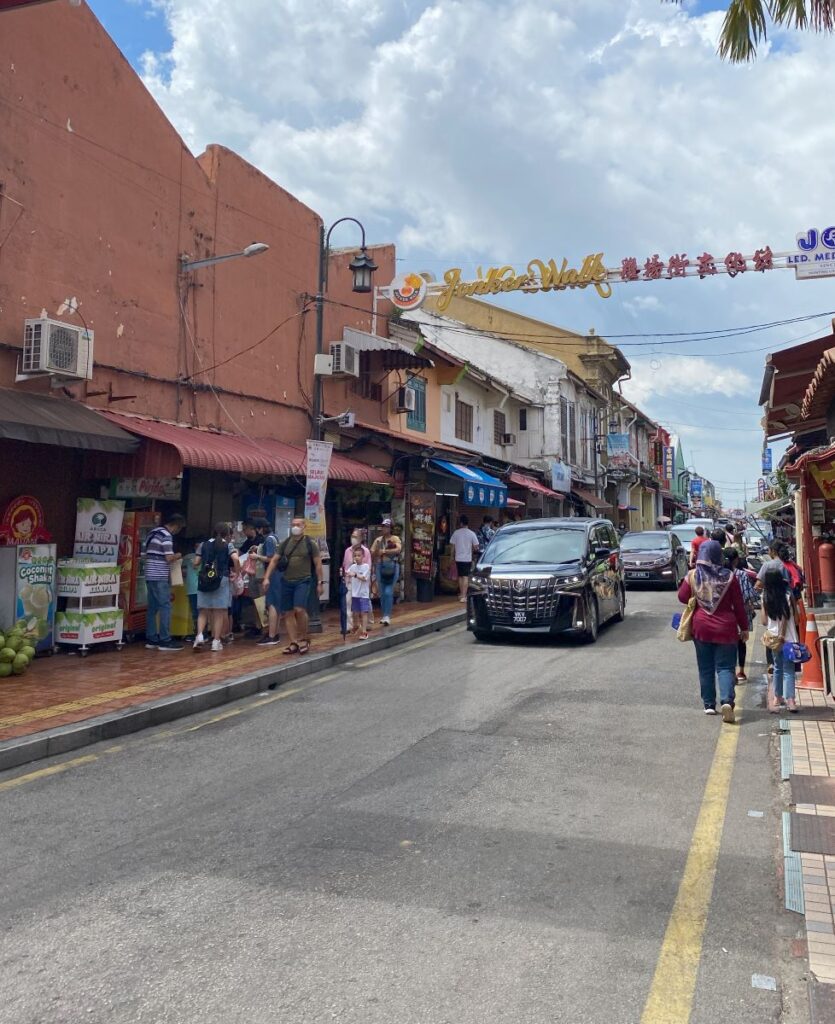
Malacca (Melaka), another UNESCO World Heritage Site, is known for its rich history and mix of Portuguese, Dutch, and British influences. Its small size and emphasis on tourism make it one of Malaysia’s most walkable cities. And it’s super cute, too!
Positives
- Jonker Street: This famous area is a hub for walking, especially during the weekend night market. You’ll find local snacks, crafts, and souvenirs all within a lively pedestrian-only zone.
- Compact Layout: The historic center is small enough that you can walk between major attractions like A Famosa fort, St. Paul’s Hill, and Christ Church without needing transport.
- Scenic Riverside: The Malacca River runs through the city, and the riverside walk is a nice way to explore cafes, murals, and nightlife.
Challenges
- Weekend Crowds: Jonker Street and the surrounding areas can become very crowded, especially during the night market, which might make walking less enjoyable. I also found the streets VERY narrow with the added stalls and crowds– highly unpleasant, as I despise being shoulder-to-shoulder with people.
- Limited Sidewalks: Some streets lack proper sidewalks or have uneven surfaces, requiring extra caution when walking. The main tourist areas have nicer pavement and wider sidewalks, but the crosswalks are out of the way and a little annoying to get to. Most people just end up jaywalking.
Neighborhoods of Interest
- Jonker Street Area: Central to most attractions and perfect for exploring food stalls, shops, and historic buildings. Tends to be very loud, as it’s the busiest part of town.
- Riverside: Offers a relaxed, scenic walk with cafes and art along the Malacca River. Very fancy hotels here.
- Portuguese Settlement: Slightly outside the main area but walkable within its vicinity, this neighborhood is known for its unique cultural heritage and seafood restaurants. Feels more local.
4. Singapore
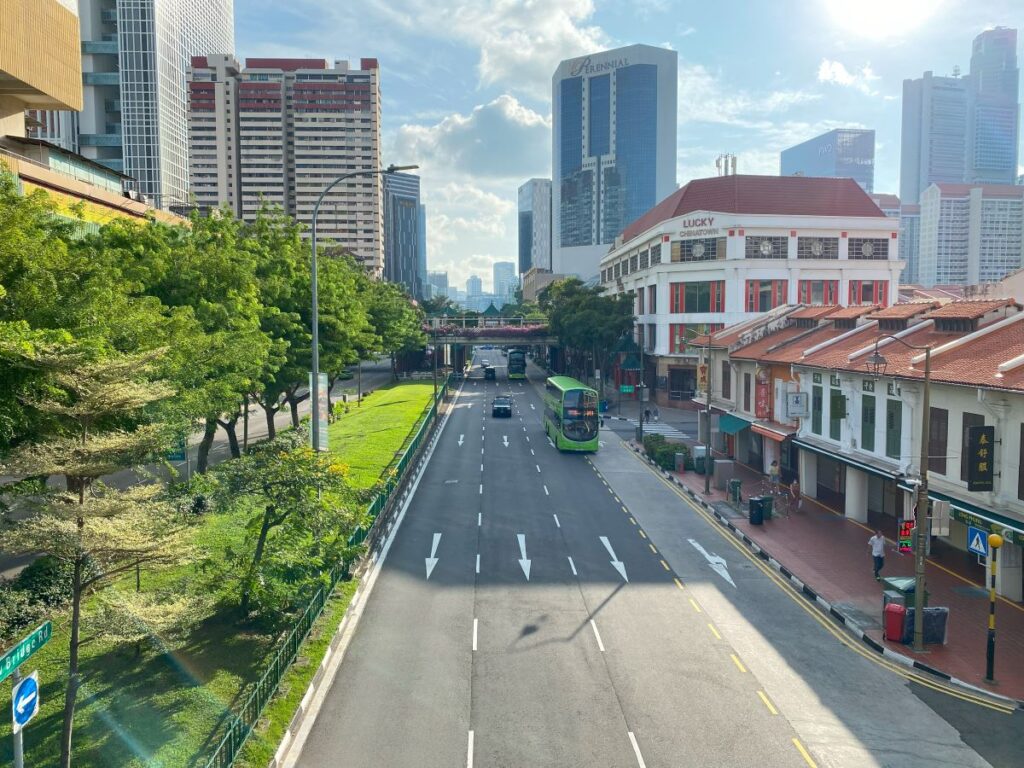
Singapore is renowned for its excellent urban planning and pedestrian-friendly infrastructure. As one of the safest and cleanest cities in the world, it’s a haven for those who enjoy walking while exploring. Huge sidewalks, nice crosswalks, well-maintained and clean: an absolutely wonderful place to walk around and explore!
Related: 10 Best Singapore Food Tours & Experiences
Positives
- World-Class Infrastructure: Singapore’s sidewalks are wide, clean, and well-maintained, with clear pedestrian crossings and plenty of shaded areas. Many sidewalks have awnings, too, especially ones leading to bus stops or metro stations.
- Green Spaces: The city’s parks, such as the Singapore Botanic Gardens and Gardens by the Bay, are wonderful for walking in nature. There are also scenic walking trails like the Southern Ridges.
- Safe and Accessible: With low crime rates, Singapore is extremely safe for pedestrians, including at night.
Challenges
- Tropical Heat and Rain: The hot and humid climate can be challenging for walking long distances, and sudden rain showers are common. If you’re planning on walking around a lot, I recommend acclimatizing to the heat ASAP. It’s tempting to spend all your time in air con, but it makes going outside in the heat more difficult.
- Cost of Living: The most expensive city on this list, with even the hostels starting at about $30 USD/night.
Neighborhoods of Interest
- Chinatown: A mix of historic charm and modern amenities, with walkable access to temples, hawker centers, and boutique shops.
- Tiong Bahru: Known for its art deco architecture, trendy cafes, and local markets, this neighborhood is a favorite among expats and locals alike.
- Marina Bay: A modern area with iconic landmarks like the Marina Bay Sands, the Merlion, and the Helix Bridge, all within a pedestrian-friendly zone. Very expensive area in an already expensive city.
5. Ubud, Bali, Indonesia
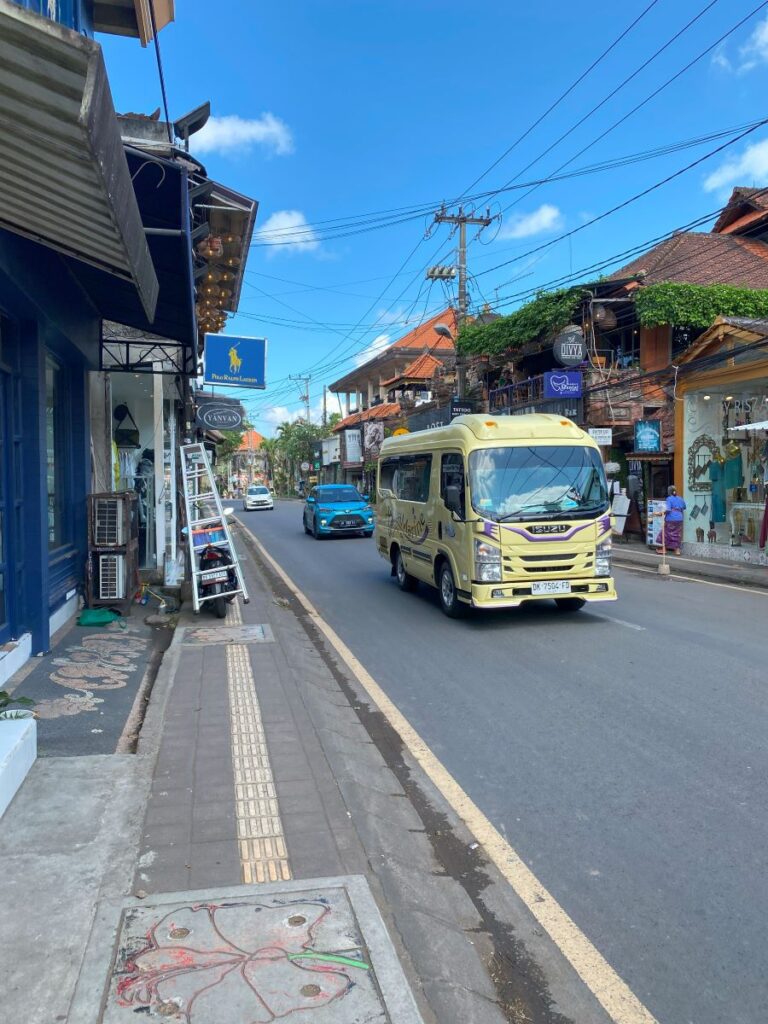
Ubud, located in Bali’s central highlands, is known for its lush greenery, cultural heritage, and laid-back vibe. While not a traditional city, it’s a popular spot for slow travelers seeking a walkable environment in a more spiritual atmosphere. I stayed here for a week and really enjoyed it, though that might be partly because I prefer mountains over beaches.
I debated putting Ubud on this list, but I think it has potential. The most annoying thing about walking around Ubud is the taxi drivers trying to get you to hire them– and the horrible sidewalks. Ubud has maybe the WORST sidewalks on this whole list, and honestly most of the time you have to walk in the street. But it’s such a charming town otherwise! So…I’m torn.
Positives
- Central Ubud: The main town area is compact and walkable, with access to markets, temples, and cafes. The Ubud Art Market and Ubud Palace are within walking distance from most places.
- Nature Walks: Trails like the Campuhan Ridge Walk offer scenic walking opportunities through rice fields and lush landscapes. And since it’s in the wilderness (somewhat), you won’t have to fend off taxi drivers calling “taxi! taxi!”
- Cultural Activities: Ubud’s filled with yoga studios, art galleries, and traditional dance performances.
Challenges
- Traffic and Sidewalks: Narrow sidewalks, usually falling apart somehow, with all kinds of things on them like scooters and boxes and dog poop. Walking in the street is a little better, but you’ll need to keep an eye out for tourists on scooters– they usually don’t know how to drive properly and run into things (and people).
- Tourist Crowds: During peak seasons, Ubud’s small streets can feel congested with tourists, which just makes everything worse.
Neighborhoods of Interest
- Central Ubud: The heart of the town, with easy access to cafes, markets, and cultural landmarks.
- Penestanan: A quieter area known for its artist community, walkable paths, and proximity to rice fields.
- Nyuh Kuning: A peaceful neighborhood near the Sacred Monkey Forest Sanctuary, with nicer streets/sidewalks and local charm.
6. Hanoi, Vietnam
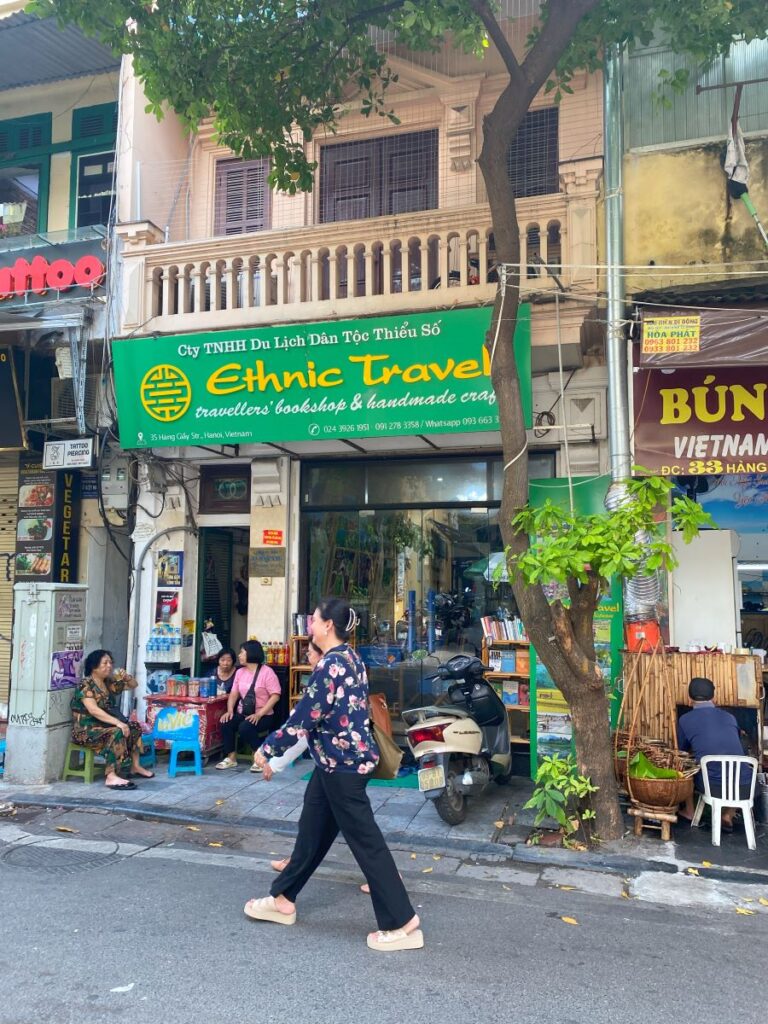
Hanoi, Vietnam’s capital, is a vibrant city with a mix of old-world charm and modern energy. Its busy neighborhoods make it a fascinating place to explore on foot. Like Ubud, it’s got crazy-busy sidewalks full of people, scooters, and broken bits, but it’s got some okay areas which you can walk around easier.
Read more: Hanoi’s French Quarter Walking Tour Review
Positives
- Old Quarter: The most famous area for walking, with narrow streets packed with shops, street food vendors, and historic sites like Hoan Kiem Lake.
- French Quarter: This district features wider boulevards and colonial-era buildings, making it a more relaxed area to walk compared to the Old Quarter.
- Cultural Richness: Hanoi’s streets are filled with pagodas, museums, and traditional performances, offering plenty to explore.
Challenges
- Traffic and Crossings: The chaotic traffic can be intimidating, and crossing streets requires patience and confidence due to the lack of clear pedestrian signals. The crosswalks basically don’t work, if they’re there at all. This is when you have to figure out how to cross a street in Vietnam.
- Air Quality: Pollution levels can be high, especially during peak traffic hours, which might make long walks difficult.
Neighborhoods of Interest
- Old Quarter: A lively area with endless options for street food, shopping, and sightseeing. Maybe TOO lively for a long stay, in my opinion, but worth visiting for a few days. Keep in mind it has sidewalks, but the sidewalks are full of stuff and can’t be used by pedestrians. Everyone just walks in the street.
- French Quarter: Offers a more peaceful walking experience, with tree-lined streets and landmarks like the Hanoi Opera House. Still fairly busy but not as crowded as Old Quarter.
- Tay Ho: A favorite among expats, this area around West Lake has walkable paths, cafes, and a more laid-back atmosphere. If you hate the busy-ness of the Old Quarter, try here! I stayed here for a few days and found it much calmer than the rest of the city.
7. Da Nang, Vietnam
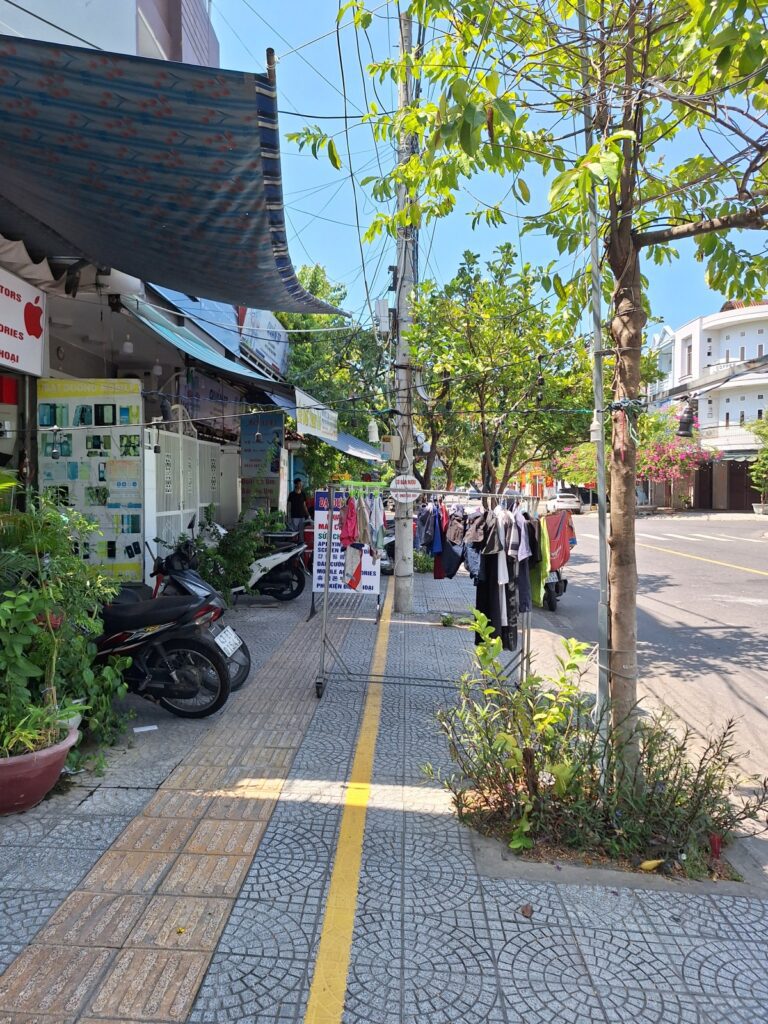
Da Nang, a coastal city in central Vietnam, is known for its modern infrastructure and scenic beauty. There’s a beach, there’s a big city, there’s lots of events and things to do! Many, many expats come here and the city is well-equipped for visitors.
I stayed 3 months in Da Nang and highly enjoyed it. It’s one of the better places for walking around, but getting between neighborhoods is a little easier on a scooter. The sidewalks are generally nice (and wide), but they’re also full of parked scooters.
Positives
- Beachfront Walks: The city’s My Khe Beach has a long, walkable promenade perfect for morning or evening strolls.
- Modern Infrastructure: Da Nang’s roads and sidewalks are well-maintained compared to many other Vietnamese cities, and the city’s layout is relatively easy to navigate.
Challenges
- Heat and Humidity: Like most of Southeast Asia, Da Nang’s weather can make long walks uncomfortable without breaks. And lots of water.
- Urban Sprawl: Some areas, particularly outside the central districts, are less walkable and require transportation.
Neighborhoods of Interest
- Son Tra Peninsula: For nature enthusiasts, this area offers trails and scenic walks with stunning views of the coastline.
- My Khe Beach Area: The central hub for expats, perfect for beach lovers, with a scenic promenade and nearby cafes and restaurants.
- Han Riverfront: A lively area with walkable access to the Dragon Bridge, local markets, and riverside activities. This is where I stayed! It’s quieter than My Khe and more residential, which I preferred.
An alternative (and much smaller) city is Hoi An. It’s got old-world charm and many expats find it a more beautiful place to stay than Da Nang. However, I found it had similar problems to Hanoi; it gets crowded on the streets in some parts and the sidewalks aren’t as well-maintained outside of specific streets.
Final Thoughts: Walkable Cities in Southeast Asia
Hopefully this list gave you an idea of what sort of walkable cities are in Southeast Asia! While it’s not perfect, there’s quite a few good places to try out.
Of this entire list, I think the most comfortable city to walk around in is probably Singapore, as it has the nicest sidewalks (wide, clean, well-maintained). However, places like George Town and Chiang Mai are a lot more interesting to walk around– there’s tons of tiny cafes, shops, and restaurants to explore. And finally, while Ubud and Hanoi may not be the easiest places to walk around in, they have other positive aspects that may interest you.
Have you visited any of these cities? Which would you say is the most walkable?
